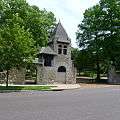Theodore Link

Theodore C. Link, FAIA, (March 17, 1850 - November 12, 1923) was a German-born American architect.
Early life
Theodore C. Link was born on March 17, 1850 in Germany. He was trained in engineering at the University of Heidelberg and the École Centrale Paris.
Career
Link emigrated to the United States, arriving in St. Louis in 1873 to work for the Atlantic and Pacific Railroad company. In 1875, St. Louis Surveyor Julius Pitzman recommended him to the job of superintendent of public parks for St. Louis, and after a four-year interim as a German-language newspaper publisher in Pittsburgh, Pennsylvania, Link returned to St. Louis as one of the architects for the 1904 World's Fair. He also "designed most of the buildings for LSU when the campus was relocated in the 1920's." [1]
Death
Link died in Baton Rouge while working on the new Louisiana State University campus,[2] and was interred at Bellefontaine Cemetery in St. Louis. In 1995 was awarded a star on the St. Louis Walk of Fame.[3]
Work
Among his list of 100+ buildings include:
- 1842 Monticello Seminary (now Lewis and Clark Community College), Godfrey, Illinois
- 1891 gates and several houses for two of St. Louis's private places, Westmoreland Place and Portland Place
- 1894 St. Louis Union Station, modeled on the fortifications of Carcassonne, with architect Edward Cameron
- 1899 Second Presbyterian Church, 4501 Westminster Place, Saint Louis, Missouri.[4]
- 1901 St. John’s United Methodist Church, 5000 Washington Place
- 1901 Wabash Railroad Station and Railway Express Agency, 780 East Cerro Gordo Street, Decatur, Illinois[5]
- 1902 Wabash Railroad Station, Danville, Illinois[6]
- 1903 Mississippi State Capitol, Jackson, Mississippi
- 1904 Palace of Mines and Metallurgy at the 1904 World's Fair (razed)
- 1904 Reid Hall and campus master plan for Washington and Lee University[7]
- 1910 Roberts Shoe (International Shoe) Company Building, St. Louis, with ornament influenced by Louis Sullivan
- 1919-1923, master plan and nine buildings for the Louisiana State University, including the Memorial Tower, with Wilbur Tyson Trueblood
Images
 Westmoreland Place gates, St. Louis, Missouri
Westmoreland Place gates, St. Louis, Missouri Portland Place gates, St. Louis, Missouri
Portland Place gates, St. Louis, Missouri Wabash Station, Decatur, Illinois
Wabash Station, Decatur, Illinois_(14572966008).jpg) Wabash Station, Decatur, Illinois
Wabash Station, Decatur, Illinois- Palace of Mines and Metallurgy, 1904 World's Fair
 Mississippi State Capitol
Mississippi State Capitol Grand Hall, St. Louis Union Station
Grand Hall, St. Louis Union Station Reid Hall, Washington and Lee University
Reid Hall, Washington and Lee University- Roberts Shoe Company Building, St. Louis, Missouri
 Memorial Tower at LSU
Memorial Tower at LSU
References
- ↑ Louisiana State University Architectural Drawings by Theodore Link, Louisiana Digital Library, Baton Rouge, La. <http://cdm16313.contentdm.oclc.org/cdm/landingpage/collection/TLD/>
- ↑ Tofts, Caroline Hewes. "Theodore C. Link, FAIA (1850–1923)" in Landmarks Association of St Louis (accessed 2 February 2015) <http://www.landmarks-stl.org/architects/bio/theodore_c_link/>
- ↑ St. Louis Walk of Fame. "St. Louis Walk of Fame Inductees". stlouiswalkoffame.org. Retrieved 25 April 2013.
- ↑ "Second Presbyterian Church St. Louis, Missouri". American Presbyterians. 68 (3): 206. Fall 1990. JSTOR 23332669. (Registration required (help)).
- ↑ Potter, Janet Greenstein (1996). Great American Railroad Stations. New York: John Wiley & Sons, Inc. p. 295. ISBN 978-0471143895.
- ↑ Railroad Gazette. Railroad gazette. 1902-01-01.
- ↑ Warren, Mame. Come Cheer for Washington and Lee. Washington & Lee University Press (Meridian Printing), 1998, p. 12.
External links
- Theodore Link at Find a Grave
- online photo and biography
- Louisiana State University Architectural Drawings by Theodore Link, Louisiana Digital Library, Baton Rouge, La. <http://cdm16313.contentdm.oclc.org/cdm/search/collection/TLD>